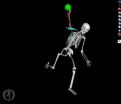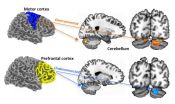(Press-News.org) What helps children who have just met form a connection? A new study shows that a simple game played together in sync on a computer led 8-year-olds to report a greater sense of similarity and closeness immediately after the activity.
Children who played the same game but not in a synchronous way did not report the same increase in connection.
The findings, published April 8 by PLOS ONE, give an example of how a physical activity performed in unison helps children feel more positively toward each other and could perhaps increase their empathy.
"Synchrony is like a glue that brings people together -- it's a magical connector for people," said lead author Tal-Chen Rabinowitch, a postdoctoral fellow at the Institute for Learning & Brain Sciences at the University of Washington.
Synchrony occurs when people interact together in time. It's a fundamental prerequisite for activities such as playing music, singing, dancing and rowing.
But the impact of synchrony goes beyond the ability to coordinate activities with other individuals. In adults, synchrony has been linked to increased cooperation and teamwork, making work more efficient and productive.
Few studies have examined whether the same is true among children.
"We wanted to see if a synchronous, rhythmic interaction could influence the attitudes of children toward peers they had never met before," Rabinowitch said.
She conducted the study at the Hebrew University of Jerusalem in Israel, where co-author Ariel Knafo is a professor of psychology. The European Research Council funded the project.
In the experiment, Rabinowitch tested 74 8-year-old children in pairs of two boys and two girls. Seated in a quiet laboratory room, the experimenter introduced herself and asked the children to introduce themselves to each other by name only.
After the experimenter explained the task, the children sat side by side in front of a video screen. An animated soccer ball bounced on both halves of the screen, and the children pressed a button whenever the ball on their side of the screen hit the floor.
For some pairs of children, the balls bounced in sync, so their fingers tapped the buttons simultaneously. Other pairs of children had out-of-sync bouncing, so they had asynchronous finger tapping.
They did two 90-second trials of the game, with a short break in between. After the game, the children filled out questionnaires about how similar and close they felt to the child they had been paired with. A control group of pairs of children answered the same questions, but did not perform the game.
Children in the synchronous group reported a greater sense of similarity and closeness.
The findings suggest that time-based synchronized activities, including in music, dance and sports, could be useful tools in bringing children closer together.
"The important ingredient is joint synchronized activity -- it is a form of collaboration where individuals perform the same movements at the same time," Rabinowitch said.
Now at the Institute for Learning & Brain Sciences, Rabinowitch is studying in detail the underlying cognitive mechanisms that enable synchronous interaction in children to shift social attitudes and enhance cooperation.
Andrew Meltzoff, co-director of I-LABS, said: "This study gives important clues about how to promote pro-social behavior in children. There may be a deep truth in saying that children care about being 'in tune' with others or that two people are in synch with each other."
In her studies with Meltzoff, Rabinowitch hopes to reveal how music, and specifically synchrony, is able to guide and improve social and emotional interactions between humans.
"The findings might be applied to formulate new strategies for education in our effort to build a more collaborative and empathic future society," she said.
And studying this phenomenon in children is especially important, Rabinowitch added, since the connection between music and social and emotional attitudes manifests itself so early in life.
INFORMATION:
The first Northern European agriculturalists used the same ornamental beads for centuries after the introduction of farming, which may indicate their resistance to the spread of farming, according to a study published April 8, 2015 in the open-access journal PLOS ONE by Solange Rigaud from New York University and colleagues.
Farming and herding were introduced 8000 years ago in Europe by populations from the Near East. Unfortunately, interactions, including cultural exchanges, between agricultural and indigenous foraging societies during this transition are poorly documented. ...
DURHAM, N.C. - A growing body of evidence in the medical community holds that greater diversity of bacteria and even worms in the digestive tract offers protection against a variety of allergic and autoimmune problems.
Germs from healthy people can be used to heal people with digestive disorders and other conditions caused by the loss of their own germs, and worms that live in the gut, called helminths, have shown success in quelling inflammatory diseases.
With this in mind, researches at Duke Medicine hypothesized that enhancing biodiversity in laboratory rats, including ...
An over-the-counter drug indicated to treat allergy symptoms limited hepatitis C virus activity in infected mice, according to a National Institutes of Health study. The results suggest that the drug, chlorcyclizine HCl (CCZ), potentially could be used to treat the virus in people. Results were published April 8 in Science Translational Medicine.
The hepatitis C virus (HCV) causes liver inflammation and often leads to serious complications such as cirrhosis. Early diagnosis and treatment of HCV can prevent liver damage. Drugs are available to treat HCV, but costs can ...
Male offspring appear to benefit more than females from the positive effects of exercise during pregnancy, an animal study by UNSW medical researchers has found.
The study in rats also found mothers who exercised moderately while pregnant reduced their offspring's body weight, insulin and blood glucose levels, potentially lessening their risk of developing metabolic disorders such type-2 diabetes later in life.
The findings were published today in the journal PLOS ONE.
The UNSW team led by Professor Margaret Morris, Head of Pharmacology from the School of Medical ...
Given the alarming rise of antibiotic-resistant bacteria, and the long lead-in time for developing novel drugs, the discovery of new ways to use the antibiotics already available and approved for use in humans is paramount. It is generally believed that to eliminate a bacterial infection before the onset of drug resistance one must treat with large doses of antibiotics, but recent research has indicated that this type of treatment might actually be driving the emergence of drug-resistant pathogens.
New research publishing April 8th in the Open Access journal PLOS Biology ...
Pioneering new research has unlocked a new technique to help combat the rise of antibiotic-resistant bacteria, that cause debilitating and often life-threatening human illness.
Researchers from the University of Exeter has shown that the use of 'sequential treatments' - using alternating doses of antibiotics - might offer effective treatment against bacterial infection.
Crucially, the research also demonstrates this technique for administering treatment also reduces the risk of the bacteria becoming resistant to antibiotics, and so maintaining the long-term effectiveness ...
EVANSTON, Ill. --- A new approach to analyzing baseball-pitching biomechanics may one day give players more personalized feedback and help prevent elbow injuries.
In a computer simulation study of baseball pitching, Northwestern University biomedical engineers found that the strength of the elbow muscles of a baseball pitcher likely play a bigger role in injury risk and prevention than previously thought.
The motion analysis approach currently used in the baseball industry to provide athletes with injury-risk feedback is not sophisticated enough to estimate what an ...
WELLESLEY, Mass. - A new study by Heather Mattila, a leading honey bee ecologist and Assistant Professor of Biological Sciences at Wellesley College, published on April 8 in PLOS ONE, reveals that inadequate access to pollen during larval development has lifelong consequences for honey bees, leading not only to smaller workers and shorter lifespans, but also to impaired performance and productivity later in life. For the first time, this study demonstrates a crucial link between poor nutrition at a young age, and foraging and waggle dancing, the two most important activities ...
In early childhood, the neurons inside children's developing brains form connections between various regions of brain "real estate." As described in a paper published last week in the journal Biological Psychiatry, cognitive neuroscientists at San Diego State University found that in children and adolescents with autism spectrum disorder, the connections between the cerebral cortex and the cerebellum appear to be overdeveloped in sensorimotor regions of the brain. This overdevelopment appears to muscle in on brain "real estate" that in typically developing children is more ...
A single infusion of an experimental anti-HIV antibody called 3BNC117 resulted in significantly decreased HIV levels that persisted for as long as 28 days in HIV-infected individuals, according to Phase 1 clinical trial findings published online today in Nature. Major funding for the research was provided by the Bill and Melinda Gates Foundation, The Rockefeller University, and supported in part by the National Institute of Allergy and Infectious Diseases (NIAID), a component of the NIH. The research was led by long-time NIAID grantee Michel C. Nussenzweig, M.D., Ph.D., ...

